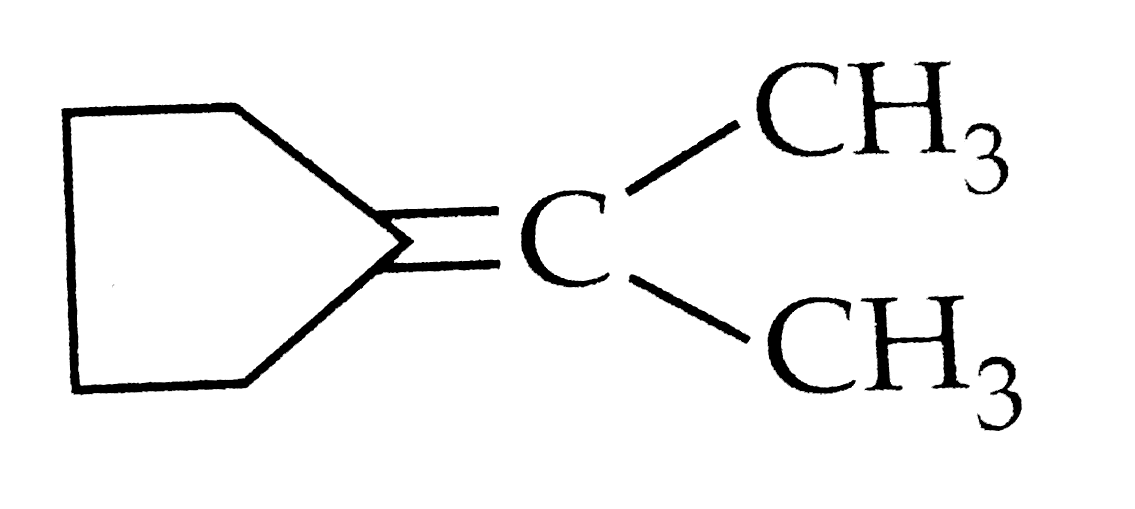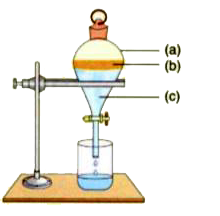An alkene (A) ozonolysis gives a mixture of two carbonyl compounds. Mixture on Clemmensen reduction gives just one alkane (B). (B) is the lowest alkane which in pure form can not be prepared by standard Wurtz method. (A) is
MeCH=CHMe
MeCH2CH=CMe2
MeCH2CH2CH2CH=CEt2
MeCH2CH2CH=C(Me)Et
The correct Answer is:B
To solve the problem step by step, let's analyze the information provided in the question and the video transcript.
Step 1: Understand Ozonolysis
Ozonolysis is a reaction where alkenes react with ozone (O₃) to form carbonyl compounds (aldehydes or ketones). The reaction typically results in the cleavage of the double bond of the alkene.
Step 2: Identify the Carbonyl Compounds
The question states that the ozonolysis of alkene (A) gives a mixture of two carbonyl compounds. This means that the structure of alkene (A) should allow for the formation of two different carbonyl products upon ozonolysis.
Step 3: Perform Clemensen Reduction
Clemensen reduction involves the conversion of carbonyl compounds (aldehydes or ketones) into alkanes using zinc amalgam (Zn/Hg) and concentrated hydrochloric acid (HCl). The question states that the mixture of carbonyl compounds from ozonolysis gives just one alkane (B) upon Clemensen reduction.
Step 4: Identify Alkane (B)
The problem states that alkane (B) is the lowest alkane that cannot be prepared by the standard Wurtz method. The lowest alkane is methane (CH₄), which cannot be synthesized using the Wurtz reaction, as it requires two alkyl halides to produce a higher alkane.
Step 5: Determine the Structure of Alkene (A)
Now we need to find an alkene (A) that, upon ozonolysis, produces carbonyl compounds that, when reduced, yield methane (CH₄).
Step 6: Analyze Possible Alkenes
1. Option A: CH₂=CH₂ (Ethylene)
- Ozonolysis gives CH₃CHO (acetaldehyde) + CH₃CHO (acetaldehyde).
- Clemensen reduction gives C₂H₆ (ethane) - ruled out.
2. Option B: CH₃C(CH₃)=CH₂ (Isobutylene)
- Ozonolysis gives CH₃CHO (acetaldehyde) + CH₃C(=O)CH₃ (acetone).
- Clemensen reduction gives C₄H₈ (butane) - ruled out.
3. Option C: CH₂=CH-CH₂-CH₃ (Butene)
- Ozonolysis gives CH₃CHO + CH₃C(=O)CH₂CH₃ (butan-2-one).
- Clemensen reduction gives C₄H₈ (butane) - ruled out.
4. Option D: CH₃-CH=CH-CH₃ (2-Butene)
- Ozonolysis gives CH₃CHO + CH₃C(=O)CH₃ (acetone).
- Clemensen reduction gives C₄H₈ (butane) - ruled out.
Conclusion
After analyzing the options, we find that none of the alkenes produce methane upon Clemensen reduction. However, the key is to find an alkene that produces carbonyl compounds that can yield methane when reduced.
The correct alkene (A) that meets the criteria is 2-Methylpropene (isobutylene), which produces acetaldehyde and formaldehyde upon ozonolysis. The Clemensen reduction of these products yields methane.
Final Answer
(A) is 2-Methylpropene (isobutylene).
---
Ozonolysis is a reaction where alkenes react with ozone (O₃) to form carbonyl compounds (aldehydes or ketones). The reaction typically results in the cleavage of the double bond of the alkene.
The question states that the ozonolysis of alkene (A) gives a mixture of two carbonyl compounds. This means that the structure of alkene (A) should allow for the formation of two different carbonyl products upon ozonolysis.
Clemensen reduction involves the conversion of carbonyl compounds (aldehydes or ketones) into alkanes using zinc amalgam (Zn/Hg) and concentrated hydrochloric acid (HCl). The question states that the mixture of carbonyl compounds from ozonolysis gives just one alkane (B) upon Clemensen reduction.
The problem states that alkane (B) is the lowest alkane that cannot be prepared by the standard Wurtz method. The lowest alkane is methane (CH₄), which cannot be synthesized using the Wurtz reaction, as it requires two alkyl halides to produce a higher alkane.
Now we need to find an alkene (A) that, upon ozonolysis, produces carbonyl compounds that, when reduced, yield methane (CH₄).
1. Option A: CH₂=CH₂ (Ethylene)
- Ozonolysis gives CH₃CHO (acetaldehyde) + CH₃CHO (acetaldehyde).
- Clemensen reduction gives C₂H₆ (ethane) - ruled out.
- Ozonolysis gives CH₃CHO (acetaldehyde) + CH₃C(=O)CH₃ (acetone).
- Clemensen reduction gives C₄H₈ (butane) - ruled out.
- Ozonolysis gives CH₃CHO + CH₃C(=O)CH₂CH₃ (butan-2-one).
- Clemensen reduction gives C₄H₈ (butane) - ruled out.
- Ozonolysis gives CH₃CHO + CH₃C(=O)CH₃ (acetone).
- Clemensen reduction gives C₄H₈ (butane) - ruled out.
After analyzing the options, we find that none of the alkenes produce methane upon Clemensen reduction. However, the key is to find an alkene that produces carbonyl compounds that can yield methane when reduced.
(A) is 2-Methylpropene (isobutylene).
Similar Questions
Knowledge Check
Which of the following alkenes on ozonolysis gives a mixture of ketones only?
ACH3−CH=CH−CH3BCH3−C∣CH3−CH=CH2C DH2C=CH2
DH2C=CH2
Which of the following alkenes on ozonolysis give a mixture of ketones only?
View Solution
Give one example of a mixture which can be separated using this method.
View SolutionAn alkene 'A' (molecular formula C5H10) on ozonolysis gives a mixture of two compounds 'B' and 'C'. Compound 'B' gives positive Fehling's test and also forms iodoform on treatement with I2 and NaOH. Compound 'C' does not give Fehling's test but forms iodoform. Identify the compounds A, B and C. Write the reaction for ozonolysis and formation of iodoform from B and C.
View SolutionAn alkene 'A' (molecular formula C5H10) on ozonolysis gives a mixture of two compounds 'B' and 'C'. Compound 'B' gives positive Fehling's test and also forms iodoform on treatement with I2 and NaOH. Compound 'C' does not give Fehling's test but forms iodoform. Identify the compounds A, B and C. Write the reaction for ozonolysis and formation of iodoform from B and C.
View SolutionAn alkene 'A' (molecular formula C5H10) on ozonolysis gives a mixture of two compounds 'B' and 'C'. Compound 'B' gives positive Fehling's test and also forms iodoform on treatement with I2 and NaOH. Compound 'C' does not give Fehling's test but forms iodoform. Identify the compounds A, B and C. Write the reaction for ozonolysis and formation of iodoform from B and C.
View SolutionOn ozonolysis, an alkene (x) forms two carbonyl compounds namely butan - 2 - one and methanal. The total number of methyl groups present in alkene (x) is
View SolutionThe reductive ozonolysis of an alkene gives a mixture of acetone and formaldehyde. What is the structural formula of the alkene?
View Solution
